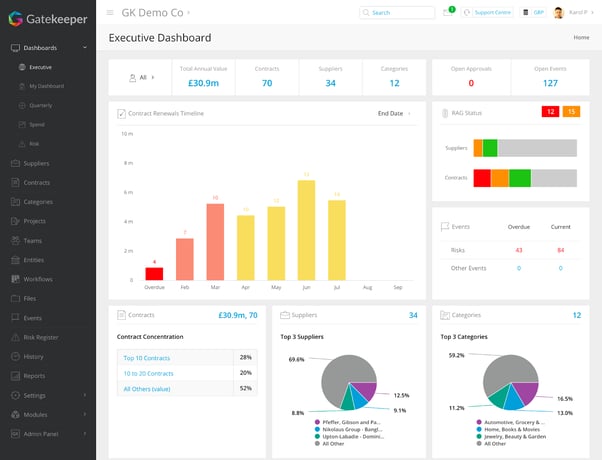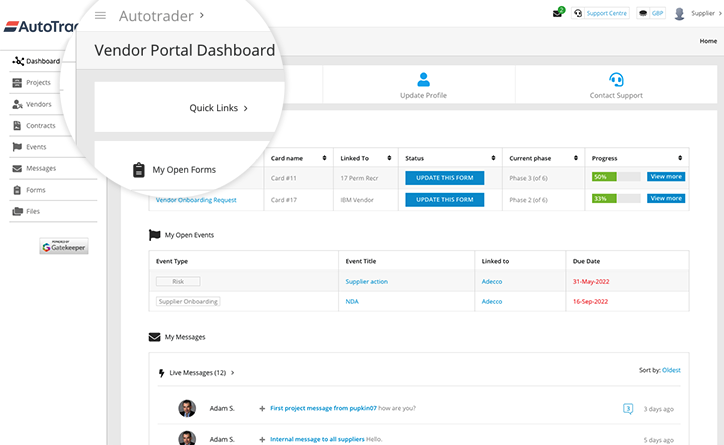The strength of your business’s vendor relationships is strongly correlated with its overall success. When these relationships are mutually-beneficial and managed effectively, your business can be confident of continuity and better outcomes.
Yet, 87% of organisations have had a disruptive incident with a third-party vendor within the past three years according to a study from Deloitte. This is a huge number, highlighting that there’s still a lot more work to be done when it comes to improving vendor relationship management.
In this article we outline which vendor management best practices should be applied and how technology can support your strategy.
What is a vendor management strategy?
A vendor management strategy is a group of processes carried out when actively nurturing relationships with third-parties, which have at least one unifying principle. These activities include communicating with vendors, reviewing their performance and mitigating any potential risks they introduce to your business.
Your business’s vendor management strategy should be designed to ensure that:
- All negotiated outcomes are fulfilled
- Third-party compliance is maintained
- Maximum value is achieved without unexpected overheads
- Business continuity isn’t disrupted
- Vendor risk is minimised
If your current approach doesn’t give you certainty about the areas outlined above, it’s time to review your strategy.
How do you manage vendor relationships?
Your business outcomes will only be as successful as its vendor relationships. If you don’t understand the status of your current vendor base, it will be difficult to nurture third-party relationships and ensure obligations are being fulfilled to a satisfactory standard.
Vendor relationships should be managed collaboratively and built on complete visibility. By working together to create an accurate view of how vendors are currently performing, your business will be able to make informed decisions about remedial actions, renewals and consolidation.
If your business is currently manually managing its vendor relationships and its understanding of key information is fragmented, a lack of visibility will hinder the ability to drive improvements in the future.
Eight Vendor Management Best Practices
Vendor management best practices allow your business to improve its current strategy and achieve optimal business outcomes.
By applying the best practices outlined below e, you can strengthen your third-party relationships, get even more value from your existing vendor base and start off on the right foot whenever you start a new vendor relationship.
1. Centralise your vendor agreements and key information
If your business can’t locate your vendor agreements, key metadata is missing or you have duplicate versions, it can’t build a thorough understanding of its vendor base. Knowledge about risk, spend and obligations will be severely limited leaving the business exposed to disruption. It could also face unexpected legal and financial consequences.
Centralising vendor agreements is the number one vendor management best practice. If storage is fragmented, so are the foundations on which you’ve built relationships."
Your business may still be using spreadsheets. It may be using platforms such as NetSuite. It could even be using a combination of tools that don’t work seamlessly together to create a single version of the truth.
If this sounds familiar, you need to create a centralised repository - housing all of your agreements and key vendor information in a single, secure location.
By storing up-to-date agreements in a single location as well as a complete record of interactions with vendors, you will always have the full picture of your vendor base. Gatekeeper offers a document repository, as well as the freedom to view aggregated reporting about individual vendor agreements or to view the entire picture.
 See all your vendor agreements in one place with Gatekeeper
See all your vendor agreements in one place with Gatekeeper
2. Build vendor risk management around market intelligence
Due diligence when onboarding any new vendor is paramount. But what may seem like a good relationship at the start can later falter if the vendor’s status changes without your knowledge. Your business needs to know absolutely everything about its vendors in order to mitigate risk and limit external threats on an ongoing basis.
Without an easy way to monitor vendors it may be tempting to de-prioritise this activity. It requires time, resources and swift actions from stakeholders when things change. But no matter how large the task may seem, it is a pivotal vendor management best practice."
Vendor management software can streamline third party monitoring with integrated market intelligence feeds. Stakeholders within your business will receive automated notifications whenever a vendor’s status changes. This includes updates to vendor credit scores, credit limits and other financial information.
Integrated market intelligence allows your business to mitigate existing vendor risk proactively. It also allows you to assess vendors before you even engage with them - so you can grow your vendor base with high-quality third-party relationships from the outset. Make informed decisions based on aggregated data from vetted financial and news sources.
3. Automate vendor onboarding and compliance
Inefficient vendor onboarding can set a negative tone for the future of your vendor relationships. Manual methods that take too long, back and forth for data collection or processes that are difficult for vendors to follow can cause early frustration, increase the risk of delay and even create vulnerabilities due to data inaccuracy.
Automating onboarding is a vendor management best practice that will save your business time, enhance your vendors’ experiences and improve data capture."
Using a branded Vendor Portal prevents process and data fragmentation, while giving your vendors a personalised experience during their onboarding.
You can also visualise the onboarding process, as well as vendor invitations and any bottlenecks causing delays. This gives you a greater ability to drive onboarding forward and eliminate inefficiencies.
By collaborating with your vendors in this way, you can also encourage your vendors to take ownership of their own onboarding.
Delegate data entry through mandatory public forms to close any knowledge gaps and automate compliance. It will reduce time spent chasing them for key information and will allow stakeholders to focus on more essential areas.
 Give your vendors a personalised experience with a dedicated dashboard
Give your vendors a personalised experience with a dedicated dashboard
4. Prioritise operational resilience by ensuring vendor security
Vendor risk management isn’t just limited to whether obligations are fulfilled. There is also a greater onus on businesses to ensure data security and compliance throughout the supply chain. Regulations such as GDPR, HIPPA and the Australia Privacy Act all outline how data should be stored and shared - especially when third parties are involved.
Despite these stringent laws, 60% of companies admit that they do not have the resources to monitor the security and privacy practices of vendors with whom they share sensitive or confidential information.'
Businesses that don’t have time and resources to dedicate to cybersecurity monitoring, should consider vendor management software. Gatekeeper, for example, partners with SecurityScorecard to give customers real-time and continuous visibility into the security status of their vendors.
By delivering security ratings, Gatekeeper ensures you can strike the right balance of trust, risk mitigation and accountability. All while protecting data security and ensuring your vendor base is compliant with your local regulations. It also saves businesses time and resources for security monitoring, providing the information you need at your fingertips.
5. Drive early remedial action with risk mitigation workflows
When applying a vendor management strategy, businesses should always consider how they can minimise any type of third-party risk. If you would consider your business to be more reactive than proactive when it comes to risk, then you may be finding it's already too late to resolve the issues at hand. Visibility and early action are all keys to mitigating risks and maintaining business continuity.
Businesses are always evolving so it’s best practice to ensure your vendor management strategy is too. Retrospective risk management needs to be a thing of the past."
Centralising, measuring and analysing third-party risk can be automated with vendor management software. Gatekeeper offers a dedicated Risk Module that allows businesses to assign Risk Scores based on probability and impact, as well as report on levels of risks via a customisable dashboard.
6. Set a vendor management policy
It’s vital to know what risks your vendors can potentially introduce to your business. But it’s also important to know the likelihood of it happening and how much work is required to mitigate it.
By segmenting vendors according to the level of risk they pose, risk mitigation becomes a strategic activity. It’s about proactivity rather than reactivity. "
Your business should also consider the criticality of your vendors. If your biggest vendor can’t prove their compliance, what impact can this have on your reputation? If a vendor shares confidential business-critical information, can it completely disrupt your organisation?
Once you have segmented your vendors and know what levels of risk they can introduce, your business needs to create its policies.
Policies in this context are a defined list of actions that stakeholders commit to in order to minimise risk.
To apply this vendor management best practice, you need to:
- Build a cross-functional team, including stakeholders from Procurement, Finance and Legal to define the policies
- Create a list of all your vendors and gather information about their level of risk. MarketIQ and SecurityScorecard from Gatekeeper can make this easier for you.
- Identify all regulations that need to be complied with.
- Periodically review compliance from your vendors, checking certificates and other documents are up-to-date
- Formalise what policy failure looks like and the actions required when this occur
- Get buy-in from all stakeholders and confirmation that they understand the policy
- Execute the policy in full and notify vendors
- Monitor the strategy and identify relationships between your policy and levels of risk
To keep everyone on the same stage, take consistent actions and effectively mitigate risk, the vendor management policy should be made visible to the entire organisation.
7. Set KPIs and track vendor performance
Vendor relationships should never just be left to run in the background. Your business needs to actively nurture these connections, particularly those with your strategic vendors. Time dedicated to nurturing vendors won’t always be based on positivity and smooth sailing, though.
Just like personal relationships, boundaries and expectations need to be set. And if your vendors overstep or underperform, uncomfortable discussions may need to take place.
There are ways to base these conversations in facts and metrics. It should never be approached with hurt feelings or personal perceptions. To set boundaries and expectations from the outset, your business should outline KPIs.
Vendor management KPIs can include:
- Compliance with industry regulations and local law
- Timely and accurate delivery of services or goods
- Product or service quality - is this always as expected or have their been any defects
- Obligation fulfilment rate and how often this hasn’t been met.
- Availability of your vendors when something goes wrong and operations are disrupted.
- Competitiveness within the market and whether your vendors always offer the best price available
These should be defined during the negotiation phase. KPIs need to be mutually agreed upon and also benefit both sides. Without an element of understanding and buy-in from your vendors, the KPIs laid out will fail to have any meaning or impact.
The KPIs can help to determine the success of the relationship, but only if these metrics are being used strategically within your business."
If KPIs are simply written down for the sake of it, it’s a task that’s not worth completing in the first place. Performance metrics are designed to keep your vendors accountable. But this can only be done if performance reviews are taking place in a regular cadence. Reviewing vendors is best practice for businesses that want to improve outcomes and get the best possible value from agreements.
Gatekeeper makes it easy to apply this practice by:
- Allowing users to use key dates to trigger notifications about reviews
- Automating workflows and giving businesses opportunities to proactively build in time for performance reviews
- Giving stakeholders automated surveys that help to measure and analyse perforce
- Providing visual data results that make it easier to compare performance between vendors
- Making it easy to identify performance patterns with in-depth dashboards.
Tracking performance doesn’t need to be another administrative burden. Gatekeeper automates and streamlines the information-gathering process so your business can see vendor performance at a glance.
8. Give vendors more ownership to boost collaboration
Any relationship requires mutual effort. It relies on understanding, communication and collaboration. Yet all too often, we speak to businesses that:
- Lose time to replicating and duplicating questions to ask their vendors
- Spend hours chasing their vendors for information via emails and phone calls
- Dedicate additional resources to sending questionnaires, inputting data and asking vendors to complete
- Have frustrated relationships with vendors because things have taken so long.
In many instances, the information captured from vendors is done manually. Businesses rely on vendors to supply their data - and it’s often done as and when vendors can prioritise the task.
In this situation, there is no limit to the amount of emails or phone calls required to make progress. For some vendors, this makes your business a nuisance. For others, they’re just too easy to ignore. "
By assigning responsibility to them, you can later hold them accountable if progress starts to stagnate. Vendor management software allows you to:
- Mandate data input from your vendors via forms during the onboarding progress
- Put the onus on vendors to safely submit updates to key records
- Set SLAs so notifications are triggered when items are overdue
- Build a complete history of what a vendor has updated and when for auditing purposes.
You may be looking to alleviate administrative work from internal teams. You may want to improve the visibility of compliance in your supply chain. Or you may simply want to collaborate more effectively with vendors. Giving them more ownership is a best practice that will help you to achieve each of these scenarios.
Wrap Up
Vendor management best practices exist to help your business get the most value from third-party agreements.
By underpinning best practices with vendor management software, your business will gain more time, accuracy and control over its vendor base. Centralisation, continuous monitoring and preventative action are all key to successful vendor management."
Whether your business wants to assess its vendor’s cybersecurity, credit status or simply wants to know where all of its vendor agreements are, Gatekeeper can help.
Book a demo with us today to discover how we can help you to apply vendor management best practices.
















.png)
.png)
.png)
-4.png)